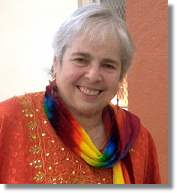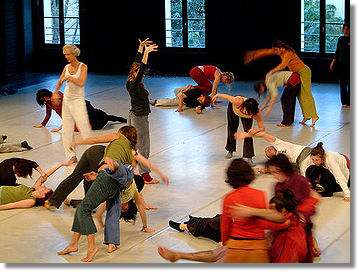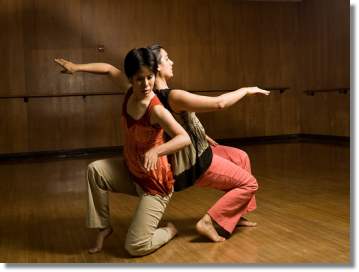Dr. Patricia Webbink - Contact Improv
 | Dr.
Webbink has been an advocate for Contact Improv for many years, for its
demonstrated therapeutic, spiritual and social value. She has
coordinated and hosted many Contact Improv events throughout the Washington D.C. metropolitan area, and has contributed to the international Contact Improv movement.
Contact
Improv (also referred to as "Contact" or "CI") is practiced as both a
concert and social dance form. In the performance context, Contact
Improvisation is used either as a dance practice end-to-itself or as a
dance research method for identifying new set choreography. | In
her spare time Dr. Webbink likes to dance or be involved in dance
programs: In May of 2012, Dr. Webbink appeared in /A Rugged Shore/:
dance performances put on by the Human Landscape Dance Company. In the
performance program it states: "A psychologist in private practice, Pat Webbink has been a contact
improv addict for the last 5 years. In her spare time, she swims and does
Tai Chi."
|
| More on Contact Improvisation (Contact Improv)?
Contact Improv
is a partner dance form based on the physical principles of touch,
momentum, shared weight, and most quintessentially - following a shared
point of contact. The form was founded in 1972 by Steve Paxton. This
dance practice explores the skills of falling, rolling, counterbalance,
lifting using minimal effort, how to make ourselves light when being
lifted, centering and breathing techniques. The dancers respond to
partnerís movements and surrounding dancerís fluidity, creating a
sensation of naturally flowing beauty and serenity.
Contact Improv has since evolved into a form of movement therapy. | |  | | |
|  | | Contact
Improvisation is an honoring of every moment. There is a sweet
surrendering that happens when our bodies stay faithful to what is
happening now, and now... and NOW! One learns to recognize and
differentiate subtle impulses in our movement choices and our partner's
choices. We begin to decipher the cues that we give and receive which
tell us when to lead or follow, when to go up, when to go down, where
to touch, how to lift, when to slow down, and when to be still. In this
form one learns to stay in integrity with each choice, never forcing,
never rushing. When Body, Mind, and Spirit are united in their
instinctive wisdom one finds ones-self at home in every moment
expressing ones true nature. - Mark Moti Zemelman |
Regularly
meetings (often weekly) of practitioners that take place world-wide are
called "jams," in which participants participate and watch as they
choose over the course of some hours. Dancers practice both known CI
technique and conduct new dance research with different partners or
groupings over the course of a jam session. The name "jam" is used in
keeping with its use by contemporary musicians, who come together to
spontaneously explore musical forms and ideas, with some group
agreement about structure and duration of the exploration
|
Further Reading:
- Novack, C, J. (1990) Sharing the Dance: Contact Improvisation and
American Culture. University of Wisconsin Press. ISBN 0-299-12444-4
- Pallant, C. (2006) Contact Improvisation: An Introduction to a Vitalizing
Dance Form. McFarland & Company, Inc. ISBN 0-7864-2647-0
- Tufnell, M. and Crickmay C. (1999) Body Space Image : Notes Toward
Improvisation and Performance. Princeton Book Co. ISBN 1-85273-041-2
- Encounters with Contact; Dancing Contact in College (2010); Edited by
Ann Cooper Albright, with Katie Barkley Kai Evans, Jan Trumbauer, David Brown
and Rachel Wortman. Oberlin College Theater and Dance. ISBN 0-937645-13-3
- Barrios Solano, M. (2004) Posthuman Performance: Dancing within Cognitive
Systems. http://dancelab1.dance.ohio-state.edu/~barrios/cord.html
- Paxton, S. (1997) in Fall After Newton. Videoda / Contact
Collaborations, Inc. (video)
- Stark Smith, N. (1987) in Fall After Newton. Videoda / Contact
Collaborations, Inc. (video)
- Touchdown Dance (2002) Contact Improvisation http://www.touchdowndance.co.uk/graphic/contact_improvisation.html
|
|
|